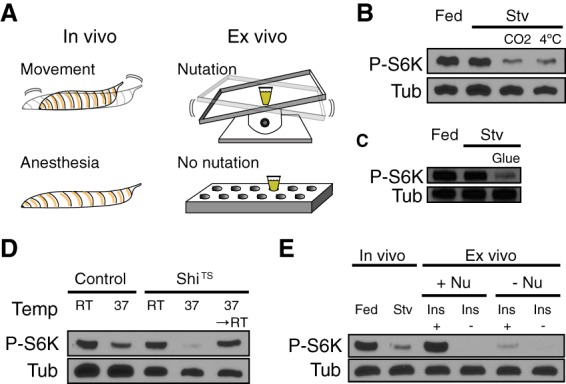Figure 1.

Movement is necessary for activation of TOR in the larval fat body. (A) Experimental control of tissue movement by anesthesia of intact larvae in vivo and nutation of larval carcasses ex vivo. (B) Anesthesia by 15-min exposure to CO2 gas or 4°C cold treatment under complete starvation (Stv; agar + water) decreased fb-TOR activity compared with starvation only. TOR activity was measured by immunoblot of fat body lysates with p-S6K antibody with tubulin (Tub) as a loading control. (C) Inhibition of larval crawling movement by superglue for 15 min reduced fb-TOR activity. (D) OK6-GAL4 (control) and Ok6-Gal4 UAS-ShiTS larvae were cultured for 15 min at room temperature (RT; permissive temperature) or 37°C (restrictive temperature for ShiTS) to inhibit larval movement. ShiTS-induced paralysis caused a loss of fb-TOR activity, which was restored by temperature shift back to room temperature for an additional 15 min. (E) Larval carcass incubation ex vivo with nutation (Nu) in M3 medium with or without 10 µg/mL human insulin (Ins) mimics fb-TOR activity under fed or starved conditions (Stv) in vivo, respectively. Without nutation, TOR activity was abolished even in the presence of insulin ex vivo.
